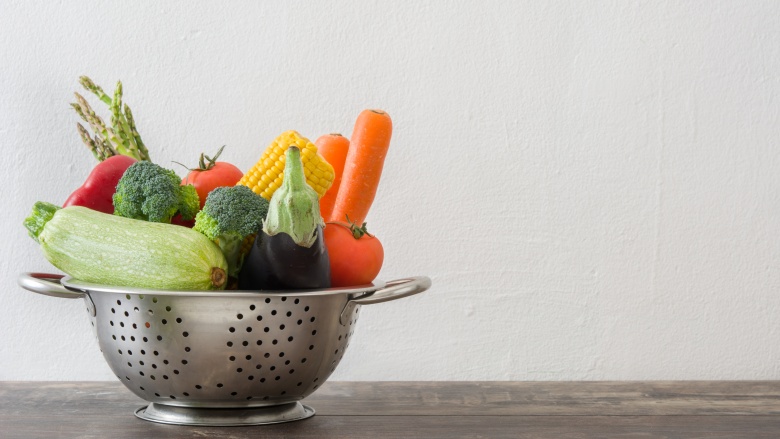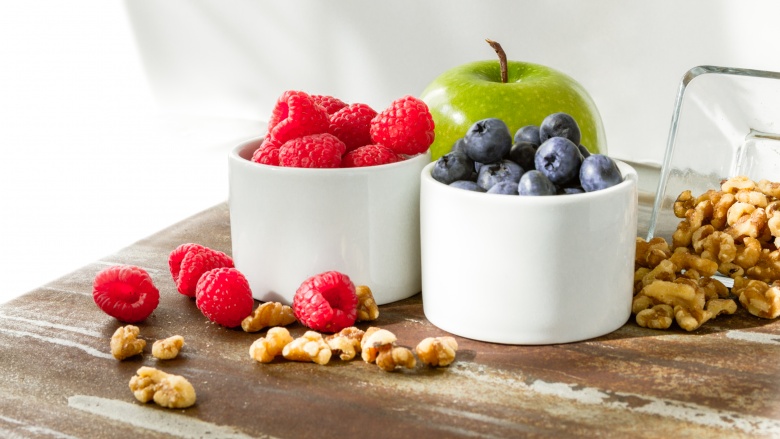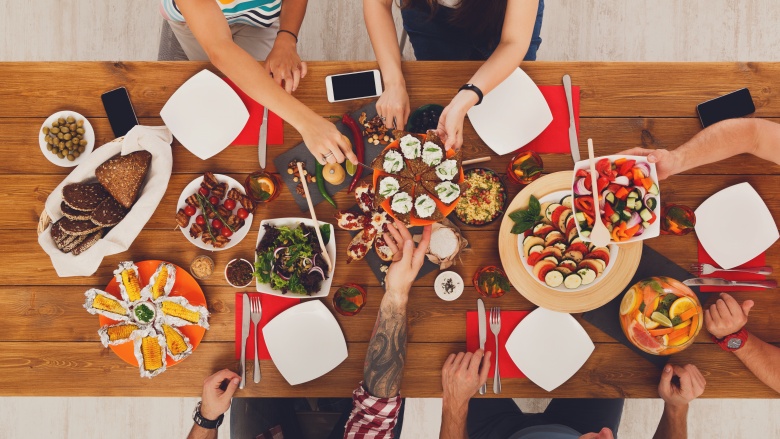The Ultimate Guide To Clean Eating
From magazines to blogs to morning news shows, the clean eating lifestyle seems to be everywhere. At its heart, clean eating focuses on eating healthy, whole, unprocessed foods. It focuses on keeping food as natural as possible.
Cookbook author and clean eating food blogger Tiffany McCauley explained why she chose to switch to a clean eating diet on her blog, The Gracious Pantry. "Food is the big ticket to good health. If you eat garbage, your body will show it," she shared. "If you eat whole, healthy, and fresh foods, your body, skin and soul will glow with health that gives you endless energy."
While these guidelines seem simple enough, the specifics can be a little confusing. Is dairy allowed? How about sugar in any form? Read on for our ultimate guide to clean eating.
What is clean eating?
Registered dietitian and "clean eating" expert Diane Welland told Cooking Light that clean eating is not a diet or quick fix. "This sound approach to eating and living well maximizes your energy and optimizes your health, making it more than just a diet," she said. "It's a lifestyle, with built-in flexibility, meaning it can be adapted to fit most any kind of routine."
Each meal should have a variety of food groups. "Include a lean protein, plenty of fresh fruit and vegetables, and a complex carbohydrate with each meal," said Clean Eating. "The steady intake of clean food keeps your body energized and burning calories efficiently all day long."
"Steer clear of anything high in trans fats, anything fried, or anything high in sugar," the magazine recommends. "Avoid preservatives, color additives and toxic binders, stabilizers, emulsifiers, and fat replacers."
Finally, part of clean eating means slowing down and enjoying your fresh food. Make sure to slowly chew your food and savor each bite.
Fresh foods
At its heart, clean eating focuses on fresh fruits, vegetables, whole grains, and lean proteins. The nice part about this eating approach is there is no need to count points or stick to a strict diet. Registered dietitian Lisa D'Agrosa, M.S., R.D. told Eating Well that clean eating is easy to understand because there is no need to count calories or give up entire groups of food. So if there aren't specific guidelines, where do we start?
With clean eating, the goal is to eat food as close to how it came from the earth as possible. "That means embracing whole foods like vegetables, fruits and whole grains, plus healthy proteins and fats," explained D'Agrosa. "It also means cutting back on refined grains, added sugars, salt, and unhealthy fats."
D'Agrosa also recommends eating plenty of healthy fats like the ones in olive oil or avocado oil. Many types of fatty fish can also provide these essential fatty acids. "These fats are good for your heart and can help raise your good HDL cholesterol, while saturated fats are associated with increased risk of heart disease and should be limited," she said.
More veggies
D'Agrosa explained why vegetables are so vital to the clean eating lifestyle in Eating Well: "Vegetables are full of vitamins, with many boasting vitamin A, which is essential for healthy vision and immune function, and vitamin K, which can help keep your bones healthy." "Vegetables are also high in heart-healthy fiber, which helps you feel full." The recommended amount of veggies in a day for adults is 2½ to 3 cups. Registered dietitian Jaclyn London, MS, RD, CDN cautioned against getting too worked up about eating the right vegetables in an interview in Good Housekeeping. "When you can figure out how to make eating more veggies work for you, the obsessing about 'clean vs. dirty' becomes irrelevant," she said. "Just find a way that works for you and your family to eat more veggies, and do that."
Nothing in a package
When you commit to clean eating, make the perimeter of the grocery store your best friend. The perimeter is where you'll find your fresh foods like fruits, vegetables, and meats. Anything on the shelves in the center of the store should be avoided. Of course there are exceptions to this rule, but generally speaking, if the food comes in a bag or box, it's not clean.
Cookbook author and clean eating food blogger Tiffany McCauley shared tips on her blog, The Gracious Pantry. "Eat mostly foods that are off a tree, bush, plant or vine, and you've pretty much got it covered," she said. "The idea is to stay away from anything that humans (food corporations) have altered in any way." Tiffany recommends reading your food labels carefully and trying to avoid any products that have more than six ingredients. Make sure you understand (and can pronounce) each and every ingredient.
Don't forget protein
Diane Welland, registered dietitian and "clean eating" expert, told Cooking Light that most of us take in plenty of carbohydrates and fats in our diets. Unfortunately we often lack good sources of protein, especially at breakfast time. "Protein is an important muscle-builder, and it can also help curb your appetite," explained Welland. "When eaten throughout the day, it keeps us feeling full longer. Be aware of the kinds of meals you put together and space out your protein."
Clean sources of protein that are good for breakfast include eggs, turkey bacon, nut butters, and quinoa. Tiffany McCauley recommends avoiding grocery store cuts of meat on The Gracious Pantry. "Eat meats that are whole and straight from the butcher," she wrote. "Don't buy pre-packaged meat products because you never know what's in them."
Ditch the sugar
New York Times best-selling author and clean eating expert Tosca Reno suggests starting your clean eating journey by cutting the sugar. "Sugar and refined products cause damage deep within the cells," she reminds us. "If your body spends all of its time trying to rid itself of the flood of sugar we feed it, how will it perform optimally?"
The clean eating lifestyle has room for some natural sources of sugar, but the focus is always on eating more fruits and vegetables. The American Heart Association recommends women limit their added sugar intake to no more than 24 grams per day. That is about 6 teaspoons, or 100 calories.
Can't go without a little sweetener in your oatmeal or coffee? Go with naturally clean sources of sugar like maple syrup, honey, and stevia. These sweeteners are still sugar, though, so go easy on them.
Smaller, more frequent meals
Clean eating usually involves smaller, more frequent meals instead of the traditional breakfast, lunch, and dinner. The argument is that having smaller meals every couple hours keeps our metabolisms buzzing away and prevents us from ever becoming too hungry. You know that moment at 4 p.m. when you realize you never ate lunch and are suddenly famished? Those are the times when you're more likely to reach for a Snickers bar, because your body is screaming at you to raise your blood sugar fast.
Registered dietitian and "clean eating" expert Diane Welland explained to Cooking Light why the clean eating plan recommends eating five to six smaller meals, as opposed to three traditional large ones. "This usually pans out into three main meals and two or three hefty snacks," said Welland. "Eating this way prevents you from skipping meals and overeating. It also keeps your blood sugar levels steady so energy doesn't lag."
Make water your BFF
It's safe to say that most of us could benefit from drinking more water. In fact, Welland explained to Cooking Light that clean eating starts with clean drinking. "High calorie drinks like specialty coffees and soft drinks, on average, tack on an extra 400 to 500 calories a day," she noted. "Choose water first, or my personal favorite, unsweetened tea (any flavor)." Drinking water throughout the day also lowers the risk of us mistaking thirst for hunger and overeating.
Watch out for clever marketing
Because everyone is talking about clean eating, food companies are taking note. That's great if they truly clean up their ingredients. Unfortunately that often means marketers are getting creative with some misleading labels. Registered dietitian Jaclyn London, MS, RD, CDN told Good Housekeeping that she is concerned about people being misled into thinking they are eating healthier foods than they truly are. "The other frustrating thing about 'clean eating' is that the phrase misrepresents scientific evidence on food ingredients. More and more marketers refer to their food products as 'clean' or having 'clean ingredient labels,'" she explained. "But if your product is 90% full of a trendy version of oil or sugar, it's still not providing consumers with healthful, educated choices."
Don't drive yourself crazy
Food blogger and author Tiffany McCauley stresses on The Gracious Pantry that when it comes to clean eating, no one is perfect. "My advice is to take baby steps. Make little changes every day and don't beat yourself up if you make mistakes. We all do," she said. "Just realize that it's what you do the majority of them time that counts."










